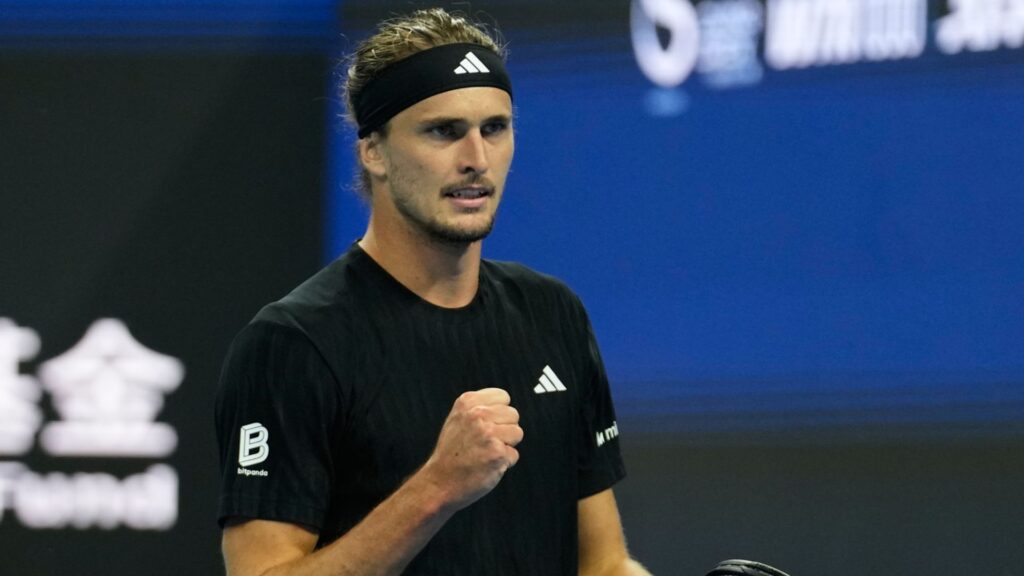
Alexander Zverev has voiced strong concerns regarding the perceived favoritism shown to the world’s top two players, Carlos Alcaraz and Jannik Sinner, at the Shanghai Masters. Following his victory over Valentin Royer with a score of 6-4, 6-4, Zverev criticized tournament organizers for deliberately slowing down the courts to benefit these top competitors. This statement reflects a growing sentiment among players about the consistency of court conditions across various tournaments.
Concerns Over Court Conditions
During his on-court interview, Zverev expressed his dissatisfaction with the direction of the sport. “I hate when it’s the same, to be honest,” he stated. He elaborated that tournament directors seem to prioritize the success of Alcaraz and Sinner, leading to a homogenization of playing conditions. “Nowadays, you can play almost the same way on every surface. I don’t like it, I’m not a fan of it,” he added.
Zverev’s comments come at a time when the game is increasingly characterized by similar strategies on different surfaces, which he believes detracts from the diversity and excitement of tennis. “Tennis needs different game styles,” he remarked, indicating a desire for greater variety in how the game is played.
In a concerning moment during the match, Zverev required treatment for a toe injury while serving for the match at 5-4 in the second set. He explained, “I landed funny on my toe and after that I could barely do a step, so we’ll see what it is.” Despite the injury, he managed to secure the win and expressed relief at advancing, saying, “I’m happy to be through.” The ATP has been contacted for comments regarding Zverev’s allegations.
Voices from the Court
Former champion Roger Federer has echoed similar concerns, specifically addressing the impact of court speeds on player performance. Appearing on the podcast ‘Served With Andy Roddick’ during the Laver Cup, Federer suggested that organizers need to provide a variety of court speeds to truly test players. “We need to have not only fast courts, but what we would want to see is Alcaraz or Sinner figure it out on lightning fast courts and then have the same match on super slow courts,” he stated.
Federer’s remarks highlight a broader issue in the sport, where consistent conditions week after week limit the players’ ability to adapt their games. He emphasized that the uniformity in court conditions has resulted in predictable outcomes across major tournaments, including the French Open, Wimbledon, and the US Open.
Australian player Nick Kyrgios has also weighed in on the debate, advocating for more variety in court speeds. “I’d like to see more variety,” Kyrgios stated. “It’s good to play on [fast] courts like these, where aggressive tennis gets rewarded a little bit more.” His comments resonate with many fans who appreciate a dynamic style of play, reminiscent of Federer’s one-two punch strategy.
Before the start of the 2024 US Open, tournament director Stacey Allaster discussed the surface speed at Flushing Meadows, aiming for a medium-fast pace to balance playstyles. “It’s where we like it to be at the start of the tournament so that as we ease into it, it gets closer to the end,” she explained, emphasizing that the court speed contributes to a successful tournament atmosphere.
The Shanghai Masters has recently seen a notable decrease in court speed, with reports indicating a drop in its court pace index from the 40-41 range in prior years to just 32.9 in 2025. This change has raised eyebrows among players and fans alike, as it starkly contrasts with the previous conditions that had encouraged a more aggressive style of play.
In other matches, British No 2 Cameron Norrie triumphed over Arthur Cazaux with a score of 6-3, 0-6, 7-6 (7-5) to reach the third round. Meanwhile, world No 7 Alex de Minaur secured a swift victory against Camilo Ugo Carabelli with a score of 6-4, 6-2 in just 88 minutes. On the other hand, Stefanos Tsitsipas withdrew from his scheduled match due to a leg injury.
The ongoing discussions about court conditions and their implications for player performance underscore a critical moment in the sport. As the tennis community reflects on these issues, the call for greater diversity in playing conditions continues to resonate, shaping the future of the game.






